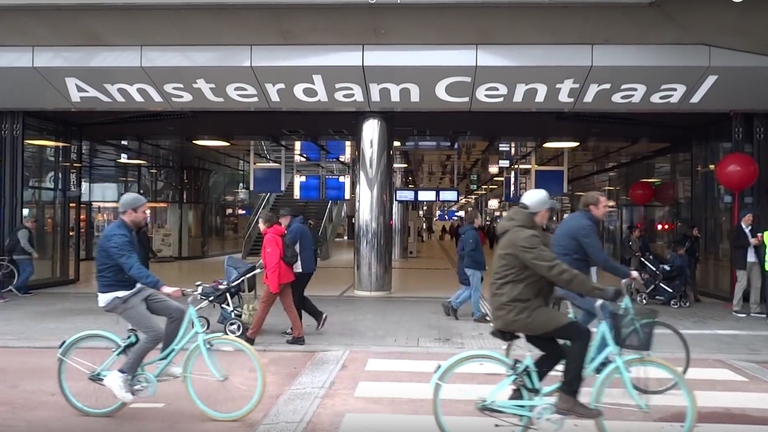
Milan has announced one of Europe’s most ambitious mobility schemes, known as Strade Aperte (open roads). Its goal is to reduce cars in phase 2 of the lockdown by increasing bike lanes and pedestrian areas.
The Netherlands amaze us all again: a tunnel for cyclists and pedestrians has been built underneath Amsterdam’s central railway station to quickly reach the trains, buses and ferries.
The tunnel running under Amsterdam’s central railway station, which was built in 1880, now allows pedestrians and cyclists to safely reach trains. Great for saving time.
The path for cyclists and pedestrians wasn’t opened as soon as the building works were finished; its opening was postponed until the tunnel was closed to cars which were diverted to another tunnel located behind the station.
The tunnel is 110 metres long, ten metres wide and three metres high. It is half cycling lane with sound-absorbing asphalt, and half large sidewalk. The pedestrian side is light-coloured and the cyclists’ side is darker. It’s nice to walk under the tunnel since there are no cars and it is lined with beautifully decorated tiles that can be seen while walking as well as cycling.
With its simple but refined design, one can reach the bus station and ferry terminal by going through this tunnel, located behind the station. Beforehand, cyclists had to pedal around the station or walk through it. It’s well lit with natural as well as artificial light, the latter being useful when it’s dark outside.
The opening of the pedestrian underpass has also aroused controversy because there were already two bike paths running around the station.
The wall decorations along the sidewalk feature a fleet of blue vessels sailing in rough seas in 1700. There are stewards who direct traffic in case of overcrowding of shared spaces outside the tunnel. In shared spaces cyclists must obviously pay attention to pedestrians, that’s why there are speed bumps for bikes where there are pedestrian crossings or the entrance into shared spaces.
Siamo anche su WhatsApp. Segui il canale ufficiale LifeGate per restare aggiornata, aggiornato sulle ultime notizie e sulle nostre attività.
![]()
Quest'opera è distribuita con Licenza Creative Commons Attribuzione - Non commerciale - Non opere derivate 4.0 Internazionale.
Milan has announced one of Europe’s most ambitious mobility schemes, known as Strade Aperte (open roads). Its goal is to reduce cars in phase 2 of the lockdown by increasing bike lanes and pedestrian areas.
Formula 1, the world’s most important auto racing championship, has decided to turn the page and aim for carbon neutrality with the support of its teams, drivers and the whole racing circus.
A trip by bike from Amsterdam to London with two cats in tow. Obviously, the four-legged travel companions didn’t run after their master Thomas, but they were on board of a peculiar cargo bike. They travelled many cities, drawing the attention of young and old passengers, due to Mushi’s and Cheesy’s big eyes looking around.
Toyota and LifeGate began telling the story of hybrid mobility back in 2006, now, on the road to the Tokyo 2020 Olympics, they’re still treading the path of sustainable mobility. Here are the main steps of the journey.
Germany’s first solar bicycle lane could be the prototype for the roads of the future. The photovoltaic tiles melt snow and ice, and are capable of absorbing noise.
The Vespa is back in an electric version. Production has just started and the first models can be reserved online starting from October.
The city of Utrecht, in the Netherlands, is home to a bridge for cycling and walking that stretches over roof garden of a Montessori school. This project enhances practicality and will allow families to bring children to school by bike, passing through green areas. Despite their functionality, bridges are often seen as an infrastructure that is
The Lego hair bike helmet is the latest Internet craze. For now it’s just a prototype but production on a large scale will probably start soon.
Just as fires often give way to new growth, after the Dieselgate scandal, which saw Volkswagen cheating on US emission rules, the German car manufacturer radically changed course, beginning to focus on sustainable mobility. The German car company aims to propose thirty zero-emission models and produce at least one million battery electric vehicles by 2025. An ambitious mission








